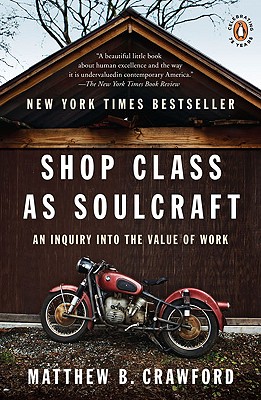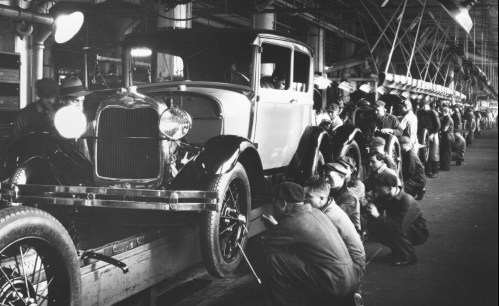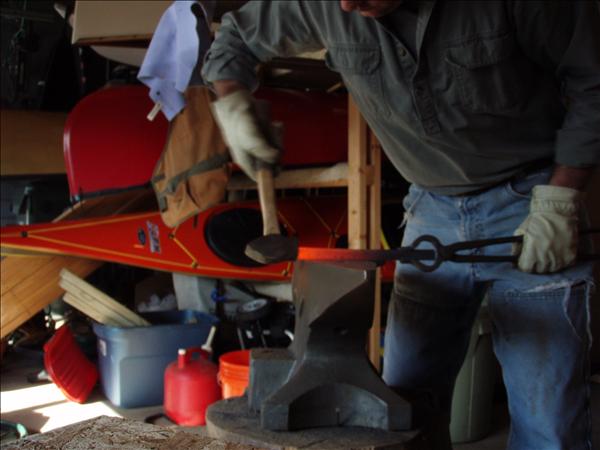 I usually bring three or four airplane books when I travel. This time the trip was short, I didn’t bring the noise cancelling headphones, an the iPod stayed in its case. I was also terribly anti-social. My row-mates were probably relieved.
I usually bring three or four airplane books when I travel. This time the trip was short, I didn’t bring the noise cancelling headphones, an the iPod stayed in its case. I was also terribly anti-social. My row-mates were probably relieved.
I had heard of Matthew Crawford’s book Shop Class as Soulcraft after I heard him interviewed on Public Radio (of course). In this book, Crawford totally nails it; what’s wrong with the American economy is that we’re snobs and narcissists. He just says it nicer than I do.
Years ago I visited one of our manufacturers in Seattle. They made a lot of cool, innovative stuff, and their factory had a lot of what I would call home grown machinery. It worked great; well thought out designs that were clever without pretense, and they were elegant in their simplicity. They’re a great tangle of microswitches, small pneumatic activators and sliding mechanisms. In other words (mine), they’re useful, kinetic sculptures.
While watching the process of creating a dry bag, I noticed a wizened, old man, capped with untidy wisps of hair, wearing a pair of work trousers and a soiled, knee-length apron. He pushed a tool cart that would have made a vascular surgeon blush. It was a thing of beauty, with a place for everything, and of course, everything in its place. It had a patina of shop-age that is impossible to replicate, just as his hands, upon closer inspection, had a patina that years of tinkering had earned him.
It was a struggle to watch the presentation, as this little old man was working on a machine a small stone’s throw away from us. As the demo ended, we walked past the old man, and no one seemed to pay attention to him. I caught his eye and smiled; he grunted a reply and gave me what might pass as a smile in some cultures. His eyes were magnified behind safety glasses with a little flip-down magnifier that allowed him close work. I would love to photograph that face.
After we passed this gentleman, I pulled aside one of the Executive VPs who had nothing to do with actually creating the product. I said “Jerry, you know who that guy is?” Jerry said “Yeah, he’s our maintenance mechanic.” “Wrong,” I said. “He’s the guy that will retire someday, and you’ll be totally screwed.”
He looked at the working man, and said, “Yep, I suppose so.” I wonder how screwed he knows they’ll be. The answer is very. I asked if he was teaching anyone how to baby these machines (for they were totally his babies). Surprisingly, no one knew. That means no, they’re not.
Since my youth I have noticed hands. My grandfather’s hands started life rough, swinging a spike maul while working on a railroad gang in the 20s. By the time I was old enough to know him, he had switched professions and was a jeweler. His hands, no longer rough, had the touch of a surgeon. My guess is a lot of surgeons would have trouble replacing a mainsprings.
Farmers, mechanics, carpenters, plumbers, electricians, stone masons; they all have their own kind of wear and tear. In my life I’ve carried cinder blocks, sweated pipes, ran table saws (another story for another day), and lathed metal in a machine shop. I’ve worked with people who use their hands for their work every day. To be frank, I prefer their company over stuffy academics.
I was the first one in my family to graduate from college. It was clear from the day I was old enough to know I was smart that I was destined for doing brain work, not physical work. I followed that path, and I did end up with a few college degrees that have not yet lined the bottom of a bird cage only because I do not own a bird.
Not that I dismiss my education as worthless; hardly, I learned a lot and am grateful for the student loans, Pell grants and Wife 1.2’s contributions. But the letters after the name; irrelevant. Sophistry, if you take it far enough, which I always do.
The problem is, according to Crawford, is that we decided a hundred years ago that intellectual work was more valuable than physical labor. By thinking, we could find ways to do things that require less physical labor. Some bloody cove named Frederick Winslow Taylor felt the need to separate “thinking” from “doing.” The basic idea is to take away the thought needed to do a task and you could save money by employing people who don’t think; they just do. Bye bye craftsman, hello replaceable drone.
At first, the workers rebelled against this new way of thinking. For every 100 new line employees, they had to hire 950 people. 850 out of the 950 felt the work was incredibly boring. The ones that didn’t quit were the ones that didn’t mind being bored, apparently.
This is not to denigrate the work done by assembly line workers (I’ve done that too). But one would be hard to argue the quality of the cars coming off the line was better. More uniform, perhaps, but not necessarily better.
Which brings me to my main points:
- What I create at my work is real, but it is certainly intangible.
- At the end of a day, I rarely have anything I can hold in my hand that signifies accomplishment.
- I don’t think I am alone here. In fact, I know I’m not.
- This is why I love blacksmithing.
I have always loved tinkering with things…often taking them apart and never putting them back together, especially when I was young. Eventually I got pretty good at putting things back together. I had a 1957 Volkswagen that challenged me and familiarized me with which end of the wrench goes where, why box wrenches are superior to crescent wrenches in all cases, and what make an internal combustion engine do its thing.
This has led to a certain handiness which has saved us huge amounts of money over the past decades. Most recently we woke up to our oven blinking an error code: F7. The manual says:
Error codes: call a service technician.
Bear in mind there are a dozen error codes. No one thought it sufficiently important to put the actual error code key in the manual. That way if you saw “F7 Error Code: Bad connection on control board” you’d have an idea that you might be tempted to fix it yourself.
Technological advances have allowed technicians to insert themselves between us and our stuff. A tune up on a 1957 Volkswagen required little but the book How to Keep Your Volkswagen Alive, A Guide for the Compleat Idiot, a 1969 hand-illustrated guide by John Muir (not the John Muir). No computers, no barrier between you and your engine.
Well, our oven was no exception. But since I don’t care about coloring inside the lines, I pulled the panel off. The oven control is a brick of electronic components, and I was never an electrician of that sort. But I pulled it off, cleaned it well, and went to put it back to see if it worked. It didn’t.
As I poked and prodded at it, I admitted defeat…this was beyond me. I didn’t have an Ohm meter to test the contacts. I called a couple of repair places. They were awful, because they can be. You’re over a barrel, pants down, and they’re holding the paddle. I was told that the control unit was shot, and that a replacement would be $400 plus labor. Plus they had to come first to confirm that it was this unit, and that would be $100 for the “diagnostic visit.”
I thought to myself, “Look, Einstein, the diagnosis is that the panel doesn’t work.” I wasn’t going to pay $100 for someone to tell me that. Frustrated, I thought I’d give it one more shot. I climbed up to take the panel off again and behind the panel, taped up on the side of the interior, was a piece of paper. It was a schematic, complete with codes and color codes for wiring the panel.
I felt like I cracked some Qabbalahistic code. This was National Treasure all over again, the hidden document behind the sancta sanctorum control panel.
I stared at it for a while. Every soldered contact on the panel was intact. Check. So it had to be the connections to the panel. A little rubbing alcohol, a little color-coded wire matching, and presto, 15 minutes later we have a functional oven.
I called the service desk of the appliance repair store. “Cancel the service call, I fixed it myself.”
“We have already dispatched the technician.”
“Sorry. I fixed it myself.”
“Are you sure it is repaired correctly?” Wrong thing to say.
“Yep, I did a diagnostic visit. It was broken. Now it’s not. Thank you for cancelling the appointment.”
Sad thing is my wife told her co-workers that I fixed our oven, which was met with astonishment and high praise. Sad, I say, because 100 years ago, no one had anything they couldn’t fix themselves, or at worst, didn’t have a neighbor who could fix it. This should not be a big deal.
One of Crawford’s points is that we’re becoming increasingly isolated from things that are supposed to be serving us; the irony is not lost on anyone, especially Mercedes Benz owners, whose cars no longer have oil dipsticks. Instead, a light comes on, informing the driver to go to a service center.
It’s my belief that it is critical to our economy if not our spirituality and humanity to return to a culture where the trades are valued rather than denigrated; that we recognize the genius in a beautiful job wiring a sub-panel; that we honor those who do things as much as those who think about things.
Respectfully (and long-windedly) submitted,
Canoelover





Awesome post that brings back “the day” when Dad fixed everything and there were no repair trucks (that I recall). Gone are the days of homes built by craftsman and not slapped together with nail guns and the like. I think the soul knows this, and that is what still draws some of us to make at least one skin on frame and/or a kit boat. Being on the water, afloat in one’s own creation, cannot match the fanciest boat purchased with a check. It’s a reflection on how society has changed and on how we spend our time. Thanks for posting it.
Spot on. Thanks for reading. And writing.
Yes, you are so right! What gets me is that most of us believe that we cannot fix it ourselves in fact we are afraid to try convinced that we are not the experts.
Great Post! I am still a fixer, if I can. My concern is for our kids, will the know how to fix anything. I remeber learning how to use a hand saw and a hoe. guess what my kids learned the same thing. We are teaching them to garden and to raise chickens, to build tables and benches. One of the best things I did for my kids was to give them their own workbenches and tools. Thanks for sharing your thoughts I too am a first to graduate from college and the first to to grow up in a two language household.